Via unveils high performance mini-ITX line
Mar 13, 2006 — by LinuxDevices Staff — from the LinuxDevices Archive — 20 views Via has announced a next-generation family of mini-ITX boards based on its new C7 processor family. “Epia EN” boards will offer a large performance boost over previous Epia boards, Via says. They target thin clients, car PCs, robotics, medical equipment, kiosks, and server appliances.
Via has announced a next-generation family of mini-ITX boards based on its new C7 processor family. “Epia EN” boards will offer a large performance boost over previous Epia boards, Via says. They target thin clients, car PCs, robotics, medical equipment, kiosks, and server appliances.
href=”/ldfiles/misc/via_epia_en_45.jpg”>(Click for larger view of Via Epia EN)
Initial Epia EN boards will feature C7 processors clocked at 1.5GHz, or else an “Eden” version of the C7 clocked at 1.2GHz, for passively cooled applications. Advanced features include support for 533/400MHz DDR2 RAM, gigabit Ethernet, and an onboard SATA II RAID 0, 1, and O+1 controller.
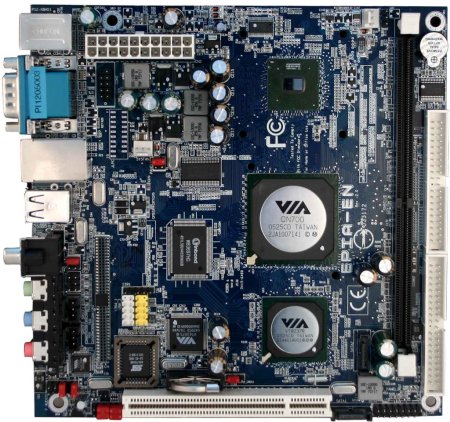
A prototype Epia EN board based on a C7 processor
(Click to enlarge)
The EN-series will eventually offer models clocked to 2GHz, with frontside-bus speeds up to 800MHz, Via says.
First C7-equipped mini-ITX boards from Via
The Epia EN boards will be the first mini-ITX boards to feature Via's next-generation x86-compatible processors, the C7 desktop, C7-M mobile, and C7-Eden embedded processors. All three are based on the same “C5J Esther” core, with different testing requirements and packaging.
Touted features of the C5J Esther core include support for SSE2 and SSE3 instructions, said to improve 3D performance; a full-speed FPU (floating point unit), rather than the half-speed unit of earlier Via chips; 16 pipeline stages; and 128KB each of L1 and L2 cache. The core also integrates Via's cryptography hardware. It has a die size of 30 square millimeters, and is manufactured by IBM using 90-namometer SOI (silicon-on-insulator) technology.
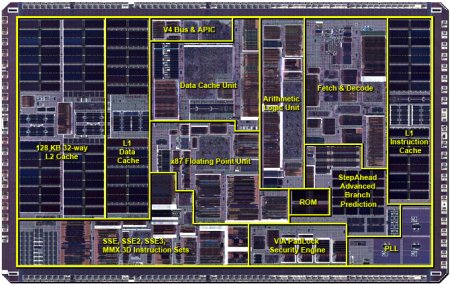
C7 die layout
(Click to enlarge)
The C7-series chips have a TDP (thermal design power, aka maximum power draw) of 12 Watts when clocked at 1.5GHz, Via says — or about half that of a Celeron-M. Additionally, the chips dissipate 20 Watts when clocked at 2GHz, Via says, and offer better performance-per-Watt than Intel's venerable Pentium M, it claims.
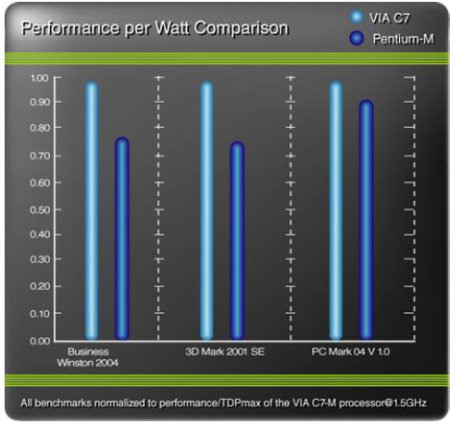
C7 vs. Pentium M in performance-per-Watt
(Source: Via)
Via announced the C7 in May of last year — see that announcement for lots more details about the chip.
CN700 Northbridge
Along with new C7 and C7-M processors, the Epia EN-series boards will use Via's relatively new CN700 chipset, which just began sampling in December. The chipset includes a new “CN700” northbridge, along with a VT8237-series southbridge connected through a V-link host controller.
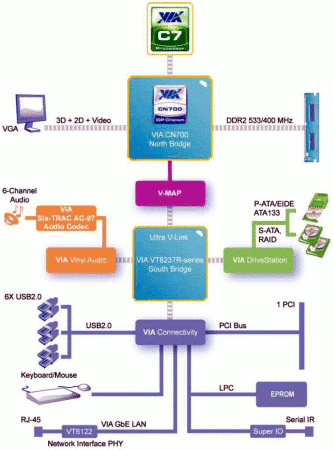
The C7 processor, CN700 northbridge, and VT8237-R southbridge function diagram
(Click to enlarge)
Claimed performance leap
Benchmarking against older mini-ITX boards based on C3 processors shows the C7-based Epia EN-series boards to offer 55 percent better results on MPEG encoding, 40 better results on business productivity performance, and about 10 percent better results on 3D graphics performance tests, Via reports.
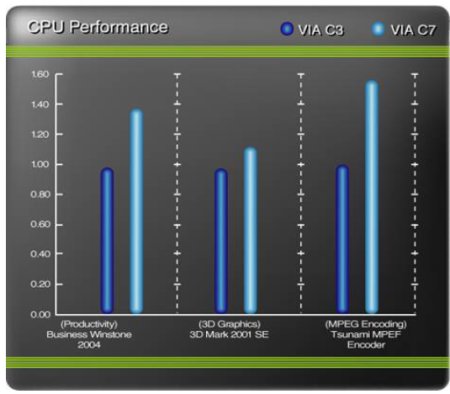
C3 v. C7 benchmark results
(Source: Via)
In addition to better performance, and performance-per-Watt, Via says the EN-series boards are more reliable, thanks to low heat dissipation. They are not as dependent as most boards on mechanical cooling systems, and don't generate enough heat to damage board components, Via says.
Other claimed features include:
- ATX power
- DDRII 400/533 memory socket
- UDMA 66/100/133 connectors
- CN700 Northbridge
- VT8237R+ Southbridge
- PCI connector
- LVDS/DVI modules available
- 6-channel audio
- Switchable (jumpers) S/PDIF / S-Video port
- PS-2 connectors
- USB 2.0
- Gigabit Ethernet
Availability
Via has not announced specific EN-series board availability, but says that boards will be available at a variety of price points soon.
This article was originally published on LinuxDevices.com and has been donated to the open source community by QuinStreet Inc. Please visit LinuxToday.com for up-to-date news and articles about Linux and open source.